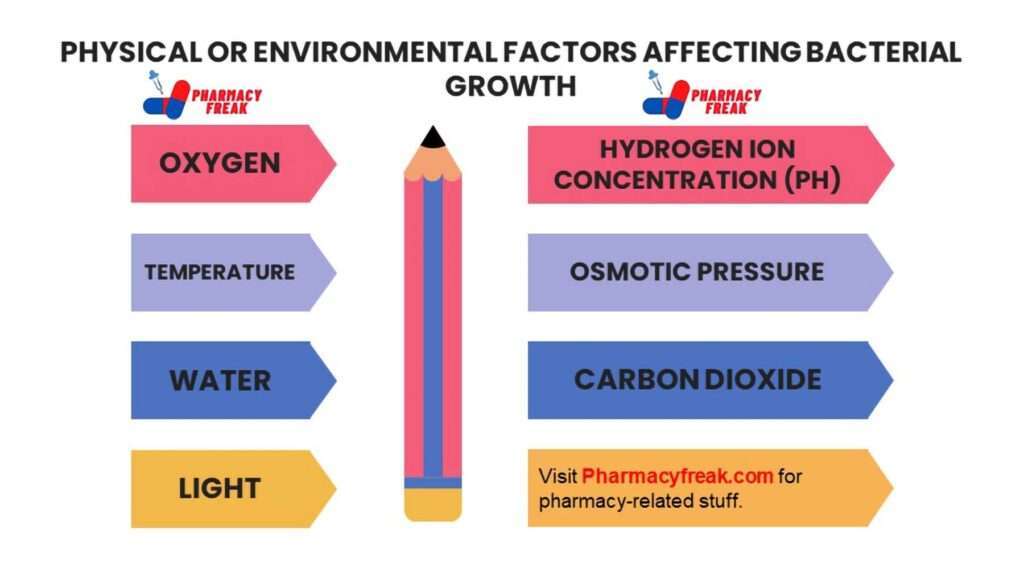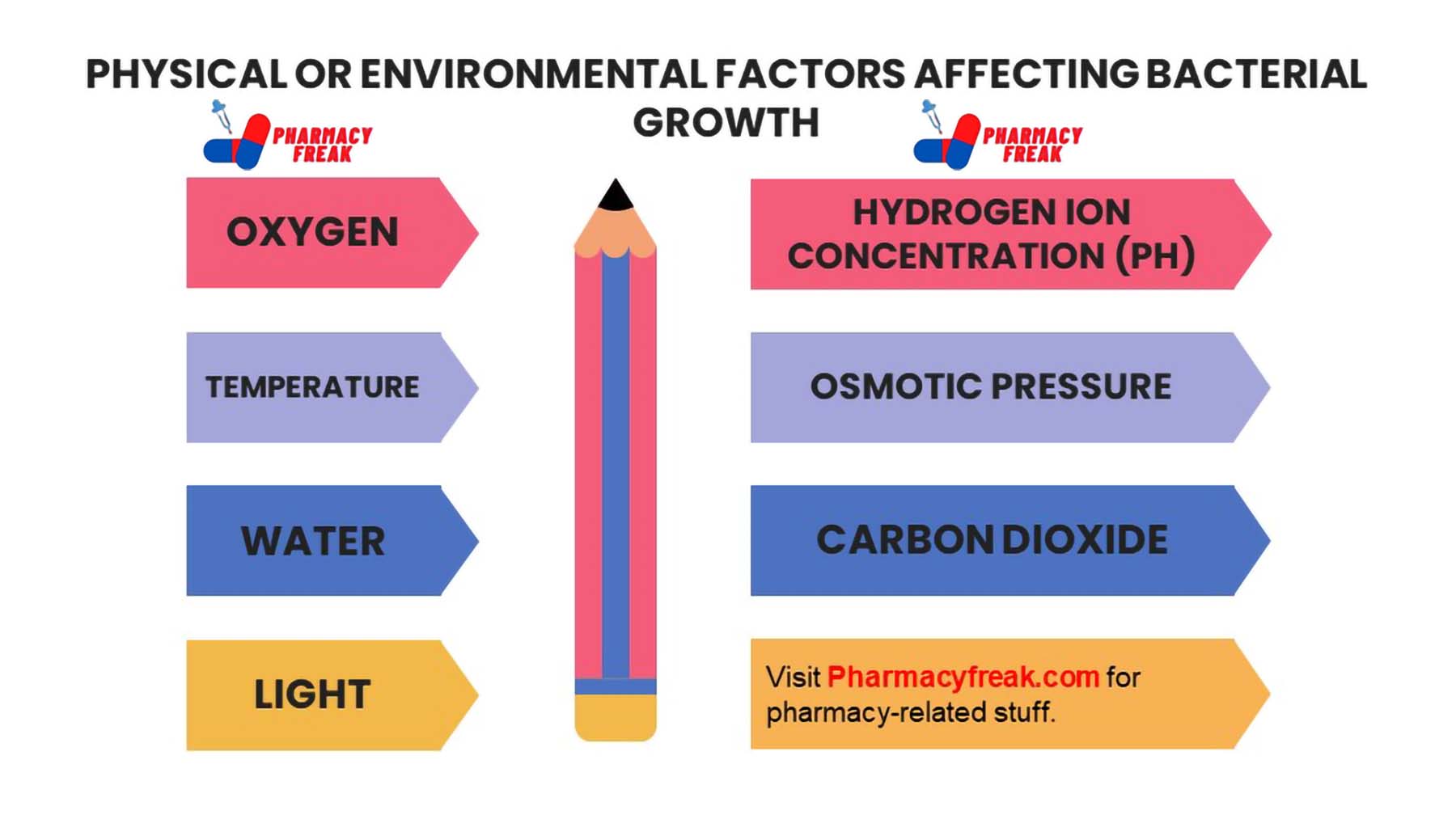PHYSICAL OR ENVIRONMENTAL FACTORS AFFECTING BACTERIAL GROWTH
The various factors affecting bacterial growth are:
- OXYGEN
- TEMPERATURE
- HYDROGEN ION CONCENTRATION (PH)
- OSMOTIC PRESSURE
- WATER
- CARBON DIOXIDE
- LIGHT

1. Oxygen
Oxygen is a universal component of cells and is always provided in large amounts by H₂O. Bacteria differ in their requirement for molecular oxygen and are mainly divided into two groups.
a. Aerobes
They require oxygen for growth.
b. Anaerobes
They do not require oxygen for growth.
They are further divided into the following groups.
i. Obligate /stringent or strict aerobes
They only grow in presence of oxygen.
ii. Obligate /stringent or strict anaerobes
They only grow in absence of oxygen.
iii. Facultative/non-stringent aerobes
They are anaerobes that can grow even in the presence of oxygen.
iv. Facultative /non-stringent anaerobes
They are aerobes that can grow even in the absence of oxygen.
Some organisms can grow best in an atmosphere of 5-10% CO2, such organisms are called ‘capnophilic’. Still, others require low oxygen levels but cannot tolerate the oxygen level present in the air atmosphere; such organisms are called ‘microaerophilic’.
2.Temperature
It is the most important factor that determines all living organisms’ growth, multiplication, and death rates. A particular microorganism will exhibit a range of temperatures over which it can grow, defined by three cardinal points in the same manner as pH.
a. Minimum temperature
It is the lowest temperature required for growth.
b. Maximum temperature
It is the highest temperature required for growth.
c. Optimum temperature
It is the temperature at which rapid growth in a short period occurs.
Based on their temperature relationships, bacteria may be divided into three main groups.
1. PSYCHROPHILES or CRYOPHILES (Greek “psychros” meaning cold)
These are the bacteria that can grow at 0 °C or lower though they grow best at higher temperatures. The term psychrophile is now restricted by many microbiologists to organisms that can grow at 0 °C but have an optimum temperature of 15 °C or lower and a maximum temperature of 20 °C -30 °C.
They are further subdivided into two groups.
i. Obligate or strict psychrophiles
They cannot grow at temperatures above 20 °C – 22 °C and die when exposed to room temperature.
ii. Facultative psychrophiles
They can grow at 0 °C but can grow best at temperatures in the range of 20 °C -30 °C.
2. MESOPHILES
These are the bacteria that can grow within a temperature range of 25 °C to 40°C.
They are further subdivided into two groups;
i. Those mesophiles with an optimum temperature of 20 °C-35 °C Bacteria which live as saprophytes and plant pathogens are included in this group.
ii. Those mesophiles with an optimum temperature of 35 °C – 45 °C. Bacteria that are pathogenic to animals are included in this group.
Thermotolerance or Thermoduric– Mesophiles are capable of withstanding high temperatures, though they do not multiply at these elevated temperatures. Psychro or Cryotolerants: They are also called psychrometric or cryogenic. These are mesophiles that can survive at very low temperatures but do not grow and multiply at such temperatures
3. THERMOPHILES (Greek “thermos” meaning heat)
These are the bacteria that grow best at the optimum temperature of 45 °C or higher but can also grow over a range of 40°C -75°C.
They are further subdivided into two groups.
i. Obligate thermophiles
They grow only at temperatures usually above 50°C and cannot grow in the mesophilic range.
ii. Facultative thermophiles
They grow at high temperatures and can also grow in the mesophilic range i.e., grow at a temperature range of 37°C -50°C.
3. HYDROGEN ION CONCENTRATION (PH)
The pH or hydrogen ion concentration [H+] of the growth medium of bacteria has a profound effect on the multiplication of microorganisms. Each microbial species has a definite pH range and depends upon this optimum pH value.
They can be classified as:
i. Acidophiles
These microorganisms have an optimum pH range in between 1-6.5 and grow at an optimum pH well below neutrality.
ii. Neutrophiles
Most bacteria fall in this category and grow best in the pH range between 6.5-7.5.
iii. Alkalophiles
These bacteria have an optimum pH range between 7.5-14.
4. OSMOTIC PRESSURE
Because of the presence of cell walls, bacteria can withstand a wide range of external osmotic pressure. The only common solute in nature that occurs over a wide concentration range is salt (NaCI) 0.5% strength is added in most culture media for creating a suitable environment for bacterial growth. Based on osmotic concentrations of substrates upon which the micro-organisms grow, microorganisms are classified as:
i. Osmophobic
Those micro-organisms that die of dehydration if subjected to substrates of high osmotic concentrations.
ii. Osmophilic
Those microorganisms that best grow on substrates of high osmotic concentrations.
iii. Halophilic
Halophiles represent those microbes that preferably grow in high osmotic concentrations produced by dissolved salts.
iv. Osmoduric
These are those microbes that grow normally on substrates of moderate osmotic concentrations but prove to be resistant to wide osmotic changes in their substratum.
5. WATER
Water is the solvent in which the molecules of life are dissolved, and the availability of water is, therefore, a critical factor that affects bacteria growth as 80% of the bacterial cell consists of water. The availability of water for a cell depends upon its presence in the atmosphere (relative humidity) or its presence in a solution or a substance (water activity). The water activity (Aw) of pure H₂O is 1.0 (100% water). Water activity is affected by the presence of solutes such as salts or sugars that are dissolved in the water. The higher the solute concentration of a substance, the lower the water activity and vice-versa. Bacteria live over a range of Aw from 1.0 to 0.7.
6. CARBON DIOXIDE:
A small amount of CO₂ is required by all bacteria which is usually made available endogenously (inside the culture medium in which bacteria is growing) as a product of cellular metabolism or by CO2 present in the atmosphere.
7. LIGHT
Bacteria (except phototrophic species) usually grow in darkness.
FAQs
What are the factors affecting bacterial growth?
Ans– The factors affecting bacterial growth are:
- OXYGEN
- TEMPERATURE
- HYDROGEN ION CONCENTRATION (PH)
- OSMOTIC PRESSURE
- WATER
- CARBON DIOXIDE
- LIGHT
